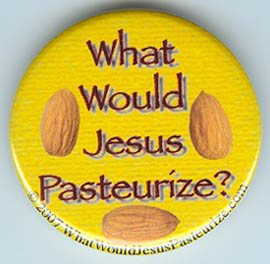The Atlanta Journal-Constitution asks an important question beyond how did the salmonella get into PCA’s Blakely, Georgia Plant — how did the 2007 Peter Pan outbreak strain get into the PCA plant?
From the AJC article:
Experts at the FDA and the CDC said they are intrigued by an unusual clue.
Two years ago the ConAgra plant in Sylvester launched a nationwide recall of Peter Pan peanut butter after consumers were sickened by a less common strain of the bacteria, called Salmonella Tennessee. It had a unique genetic fingerprint.
On Jan. 22, tests by the Minnesota Department of Agriculture found salmonella with that same genetic fingerprint in an unopened 5-pound container of King Nut peanut butter produced late last year at the Blakely plant.
The possible on-farm link to the peanut butter outbreak has been circulating around for a while (including being something ConAgra suggested during the investigation of the Peter Pan 2007 outbreak). This link reminds me of some of the stuff my good friends Linda Harris and Michelle Danyluk have looked at in the almond industry — the environmental persistence of Salmonella PT 30 and it’s subsequent transfer to the nuts (even frequent barfblogger Don Schaffner got in on some of this action). Maybe there is an environmental reservoir near of in some peanut fields. And if there is, maybe there are things that peanut producers can do to address them. The impact that this outbreak has had on peanut farmers suggests that any food safety hurdles that could be put in place is worth some investigation.
From the AJC article:
Some food safety experts questioned whether the peanut industry is aware some farming practices may increase the risk of salmonella contamination. Only one Georgia peanut farm has sought and received certification of using good agricultural practices, said Arty Schronce, a state Agriculture Department spokesman.
“My impression is the farmers really don’t have good agricultural practices,” said Michael Doyle, who has served as a consultant for ConAgra and the American Peanut Council. Doyle is director of the Center for Food Safety at the University of Georgia.
When peanuts are roasted, Doyle said, the focus may be more on achieving the right flavor rather than on safety. If salmonella is present in very large numbers, the roaster may not kill all of it, he said.
Doyle said he recently got a call from a peanut industry adviser in Georgia. “The bottom line I got from him: The farmers feel the processor is at fault and should process the salmonella out of the peanuts,” Doyle said. “They’re looking at the peanut as a commodity, rather than a food.”
I hear a lot of talk and read a lot of articles that quote food folks saying that food safety is a farm-to-fork responsibility. True. That’s why it’s a good idea that the peanut industry (and heck, other nut and seed folks as well — check this out) take these two outbreaks as indicators of something bigger — that there may be on-farm Salmonella reduction strategies employable that .
 It’s not up to me to assign blame for the outbreaks (That’s the law and Bill Marler‘s job) although I’m sure that some peanut growers will feel that’s what the AJC article is all about. It’s not — this is the first step in the public dialogue around the good agricultural practices that peanut growers currently have. If there isn’t much there, as Mike Doyle alludes to, then it’s a good idea to do the research on what the risks are figure out how to address them.
It’s not up to me to assign blame for the outbreaks (That’s the law and Bill Marler‘s job) although I’m sure that some peanut growers will feel that’s what the AJC article is all about. It’s not — this is the first step in the public dialogue around the good agricultural practices that peanut growers currently have. If there isn’t much there, as Mike Doyle alludes to, then it’s a good idea to do the research on what the risks are figure out how to address them.
Last month’s congressional subcommittee revelations revealed that there’s a bad operator in the middle of this outbreak, but peanut farmers, one of the groups hit hardest by the fallout, need to make sure they are part of the solution and truly make peanut butter food safety farm-to-fork.


 According to a
According to a